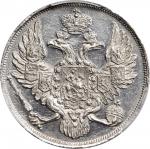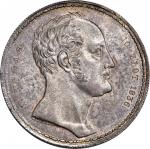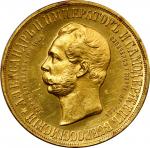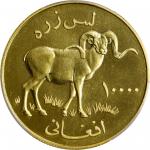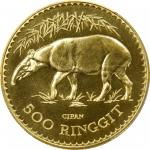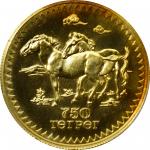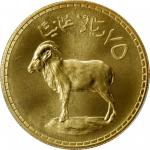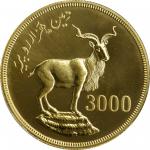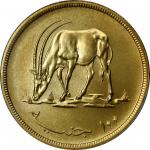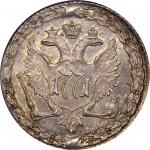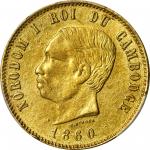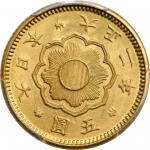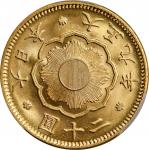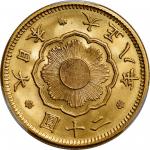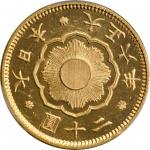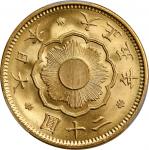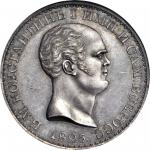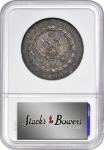1825-CNB俄罗斯1卢布银样币。圣彼得堡造币厂。康斯坦丁。
RUSSIA. Silver Ruble Pattern, 1825-CNB. St. Petersburg Mint. Constantine. NGC PROOF-62.
Spassky所著The Russian Monetary System(俄罗斯货币系统)的图版原品。直径:35.5 mm;重量:20.57 克。光边。正面:秃髮头像朝右;反面:加冕帝国双鹰,上戴皇冠,胸前有徽章,握有权杖和球体,外绕花圈。诱人的博物馆藏级样币,漂亮的深灰色,通体透现淡淡的深蓝和酒红色泽。手中转动,原厂银光从底板绽放。有两处微不足道的浅痕:一道在肖像前,另一道在正面币缘约 5 点钟方向- BCEPOCC 中第二个 C 的正下方。此品弥足珍贵,可说是所有俄罗斯钱币中最令人嚮往的巅峰之作,为继承者康斯坦丁所铸,历史价值无从比拟。康斯坦丁乃俄罗斯帝国保罗一世沙皇和符腾堡的索菲-多萝西娅群主的次子。保罗一世沙皇于 1801 年被暗杀,康斯坦丁在继承前因担心自己会落入同一命运,从未幻想过要登上宝座。于 1825 年,在其兄亚历山大一世去世后,因为亚历山大膝下无嗣,沙皇称号顺利成章由康斯坦丁继承。然而,康斯坦丁并未马上即位,反而盼望沙皇的重担(或成为暗杀目标的可能)可以转移至其弟尼古拉斯身上。因此,此枚传说中的卢布,正正就在亚历山大之死的消息传到了圣彼得堡之后(11月27日),康斯坦丁正式拒绝王位(12月12日)之前所铸。财政大臣 Egor Kankrin 和雕刻师 Johann Reichel 得悉保罗一世沙皇的死讯后立即筹备新铸币。
新铸币别具意义,打破凯瑟琳二世(大帝)和尼古拉斯二世期间採纳非肖像模具的传统,改以康斯坦丁的肖像作主题。在此短暂的空窗期间,两人打铸出五枚币缘带镌刻文字的样币,其后又不希望心血被浪费,Reichel 遂再打铸出一枚没有镌刻文字的版别(光边),最后留下共六枚,两种不同的币缘版别。十年后的 1879 年,随著对康斯坦丁拒绝即位的争议日益消散,当时的沙皇亚历山大二世从财政部的保管处将样币取出,重新检视。沙皇自身保留一枚,并捐赠了第二枚予隐士庐博物馆,最后将三枚送赠予大公乔治-迈克尔-米洛维奇,大公谢尔盖-亚历山德罗夫(他的儿子)和黑森州的亚历山大王子。时至今日,第二枚样币依然保存于隐士庐博物馆,而第一枚亚历山大二世自身的收藏亦于 1927 年转送隐士庐博物馆,随后安放于莫斯科的国家历史博物馆内。第三枚(大公乔治)最终流传至 Willis du Pont,随后更由史密森尼学会纳入集藏。第四枚(大公谢尔盖)在 1898 年于汉堡拍卖(Hamburger auction)中公开亮相,据称亦曾于1965年出现于舒尔曼(Schulman)拍卖。(当时图录中所使用的图片实际上取自隐士庐博物馆,对于最后上拍的钱币是否同为此版,大众有所揣测)而第五枚(亚历山大王子)的收藏历史最为悠久。它于 1914 年被美国著名收藏家 Virgil Brand 收购,后来于 1964 年转售另一位美国著名的经销商 Sol Kaplan,辗转再落入另一位美国领先的经销商 Abe Kosoff 集藏。数十年后的 1994 年,Kosoff的女儿最终经我司 Bowers&Merena 11月巴尔的摩拍卖会中将钱币出售。至于 Reichel 所铸的特别光边版,曾被 TF Schubert(约于1850年)和 Count I. I. Tolstoi(1863年)纳入集藏,其后和另一枚齿边版一样,于 1913 年正式被 Virgil Brand 收藏。
后来,它成为极具纪念价值的法鲁克国王收藏系列的一部分,此后再被 Abner Kreisberg 收购,最后一次于 1979 年的圣路易斯 ANA 拍卖会上公开亮相。然而,此枚并不是唯一的光边版本。普遍认为,当时 Reichel 在铸打首枚时,同时亦铸打了两枚特别的光边版。 1962 年,著名的俄国钱币学者 I. G. Spassky 博士检视了这枚迄今为止尚不为人所知的珍品。他反覆考究,观察到所使用的铸打模具是完美无瑕,无后铸时常见的鏽蚀或变质迹象,肯定其为 Reichel 所铸的珍品。随后,他将其纳入研究中,成为此版中存世已知的第八枚样币及第三枚的光边版。众所周知,此枚珍品最后成为著名的 Alexiev-Isayev-Garshin 收藏系列的旧藏,后来由 Willy Fuchs 于1981年纳入收藏。本次拍卖的珍品虽于较后期才为人所熟知,但在 20 世纪的后期已辗转出现于许多知名的收藏系列,据说由 Kobeko 收藏系列开始,落入 L. K. Joseph 收藏,再流传至F. F. von Richer。Richer 将钱币展示予 Spassky,肯定其真品的价值。最近一次面市是于 2004 年 1 月的纽约拍卖,以 525,000 美元的高价落槌(连佣金为 603,750 美元),拍后的新闻稿更称之为"世上最昂贵的非美国钱币",轰动一时。此枚风范极致的珍品在第一次世界大战前的历史仍然扑索迷离,无从稽考。当时纽约拍卖的编者推测,它很可能曾经是Count Kankrin收藏的一部分,在康斯坦丁继承前他曾任财政部长,P. V. Zubov 亦曾有如此推论。可以肯定的是,鑑于存世数寥寥无几,且有三枚已纳入博物馆馆藏,此枚于本次拍卖中公开亮相,对于钟情俄罗斯钱币的藏家而言,可说是千载难逢的机会。将如此顶尖、富历史价值的钱币纳入私人收藏中,将会是至高无上的荣耀。
KM-Pn88; Bit-1 corr. (R4); Sev-2873; Spassky, The Russian Monetary System, p. 80, this coin illustrated). Diameter: 35.5mm; Weight: 20.57 gms. Plain edge variety. Obverse: Bare head right; Reverse: Crowned imperial double eagle facing, with crown above and coat-of-arms on breast, and holding scepter and orb; all within wreath. Most alluringly toned, this charming cabinet specimen features an enticing deep gray color with some hints of cobalt and burgundy evident throughout, all while a shimmering mint brilliance radiates from beneath as one cradles it back and forth. Only for completeness, a few light marks are noted: one in front of the would-be emperor, the other near the obverse rim at 5 oclock--directly below the second C in BCEPOCC.One of the most elusive and desirable coins in the entirety of the Russian series, this majestic pattern ruble was issued for the would-be emperor, Constantine.
Born as the middle male child to Emperor Paul I and Sophie Dorothea of Wurttemberg, Constantine never saw himself as actually becoming emperor, fearful of receiving the same fate of his father, who was assassinated in 1801. Following the death of his elder brother, Alexander I, in 1825, and the lack of any legitimate sons produced by Alexander, the crown seemingly fell to Constantine, as he was heir presumptive. Constantine, however, quickly abandoned any such claim, wishing instead for the heavy burden (and possibly target) of the crown to fall to his younger brother, Nicholas.The story of this fabled ruble thus emanates from the incredibly brief period after which word of Alexanders death arrived in St. Petersburg and before Constantines official refusal of the throne: 27 November and 12 December, respectively. Minister of Finance Egor Kankrin and engraver Johann Reichel immediately began upon the prospective coinage for the new emperor, preparing dies for a portrait ruble-a break in the general tradition of non-portrait types in the period between Catherine II (the Great) and Nicholas II. Five such examples with edge lettering were then struck-either during this brief window/pseudo-interregum or slightly thereafter, the duo not wanting their handiwork to go unutilized. An additional specimen, this time without the edge lettering, was also produced by Reichel, leaving six total examples across two different edge types.
Decades later in 1879, as the perception of Constantine became far less volatile, the five examples with edge lettering were obtained from the safe-keeping of the Ministry of Finance by then-emperor Alexander II, with him retaining one for himself, donating a second to the Hermitage, and giving the final three to Grand Duke George Michaelovich, Grand Duke Sergey Alexandrovich (his son), and Prince Alexander of Hesse.The second example remains with the Hermitage, while the first passed from Alexander II to the Hermitage as well in 1927, then to the State Historical Museum in Moscow. The third (Grand Duke Georges) was eventually acquired by Willis du Pont and was subsequently obtained by the Smithsonian. The fourth (Grand Duke Sergeys) sold in a Hamburger auction in 1898, allegedly appearing in a Schulman auction in 1965 (though the image used in the catalog was in fact that of the Hermitage specimen, leading to some doubts as to what was actually sold), while the fifth (Prince Alexanders) has enjoyed a lengthier history. Acquired in 1914 by the famous American collector Virgil Brand, it was later sold in 1964 to another prominent American-dealer Sol Kaplan-before being acquired by yet another leading American dealer, this time Abe Kosoff. It remained with the Kosoffs until the sale of the collection by Kosoffs daughter in 1994 at our Bowers & Merena November Baltimore auction.Returning to the elusive plain edge variety struck by Reichel, that piece also joined its lettered edge brethren in the colossal collection of Virgil Brand, being acquired in 1913, but not before passing through the prominent collections of T. F. Schubert (ca. 1850) and Count I. I. Tolstoi (in 1863).
Later, it was part of the monumental collection of King Farouk and subsequently acquired by Abner Kreisberg, with its last known appearance being in the St. Louis ANA auction in 1979. This example, however, is not the only plain edge specimen extant, and it is generally accepted that Reichel had apparently issued two others of this particular variety along with the first. In 1962, noted Russian numismatic scholar, Dr. I. G. Spassky, inspected the present piece, which had been heretofore unknown to him. Attesting to its genuine nature, he observed that the dies used in its striking were perfect with no evidence of the rust or deterioration that would be evident from a later issue; he subsequently included it with his survey of other examples, with an eighth specimen-and third with a plain edge-becoming known to him and the rest of the numismatic community as part of the famous Alexiev-Isayev-Garshin collections, later obtained by Willy Fuchs in 1981.Our present example has seen various presentations in the latter half of the 20th century following its more humble beginning, passing from (allegedly) the Kobeko Collection to that of L. K. Joseph, then from Joseph to F. F. von Richer-a relative of whom presented the piece of Spassky for the aforementioned certification of authenticity. Most recently, it sold in the New York Sale (January 2004) for the hammer of $525,000 ($603,750 after the buyers fee) and was listed in the firms post sale press release as being the "worlds most expensive non-US coin" at the time.
What remains more mysterious is the pieces pre-World War I history, as the collection(s) of which it was a part is unknown. The catalogers for the New York Sale speculate that it may have once been part of the collection of Count Kankrin, previously mentioned for his role as Minister of Finance at the time of Constantines would be accession, and that of P. V. Zubov. What is certain, however, is that this example stands as one of the very few still obtainable, given the existence of three now held in public institutions and others that have seemingly fallen off the radar. As such, the ultimate prize for the most advanced cabinets dedicated to Russian numismatics, crown-sized silver issues, or great rarities in general.
From the Pinnacle Collection.
Ex: New York Sale VIII [Markov] (1/2004) Lot # 776 @ $525,000 hammer.
Ex: Hess-Divo 278 (4/1999) Lot # 75 @ ChF 240,000 hammer.
Ex: Sothebys London (4/1993) Lot # 474 @ GBP 28,600 hammer.
Ex: Christies New York (10/1984) Lot # 273 (unsold @ $40,000-60,000 estimate, and purportedly traded later for "Russian impressionists or enamel work").
Ex: John R. Farnell Sr. Collection (Sothebys - 12/1981) Lot # 396 (unsold @ $80,000-100,000 estimate).
Ex: F. F. von Richter Collection (presumably obtained from Josephs widow before 1938, his death).
Ex: L. K. Joseph Collection (acquired between 1916-1919, his death).
Ex: A. F. Kobeko Collection (died 1918).



